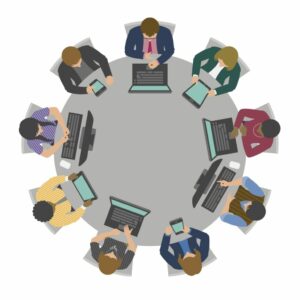Diversity and Inclusion (D&I) has generally been acknowledged by most organizations as a component of the workplace, but it has not always been a priority. Until recently, leaders traditionally focused on D&I when it made sense for their organization, location, or employee base; or was a requirement from a governing institution. 2020 was a game-changer related to not only D&I but additionally to equity and belonging. It is no longer acceptable to simply get a measure of D&I — actions and progress must be taken at the organizational, leader or manager, team, and individual levels. With this rise of visibility, organizations must address the broader construct of diversity, equity, inclusion, and belonging (DEIB) both internally and externally.
Most organizations don’t have a foundational perspective in place to guide leadership in this journey, so how can leadership create a model and process that encompasses each aspect of DEIB? While many leaders recognize the importance of DEIB, most are uncertain of how to make progress.
Similar to an “Equal Opportunity Employer” slogan on most company’s job postings, D&I policies and procedures generally existed in an employee handbook, but rarely were they examined and maintained to ensure individuals of various groups were being treated equally or whether they felt like they were included and belonged. Recent events have influenced organizations to re-examine their practices to better understand how current policies and procedures are adversely affecting various groups of employees and what actions may be taken to better foster an environment of inclusion. Leaders have begun to realize that there is a need to move beyond traditional D&I thinking and accept a broader framework of DEIB. To understand this more robust concept, it helps to begin with a brief definition of each of the DEIB factors and the relationship between them.
Diversity is defined as having a well-balanced group of employees, which can be considered the demographic makeup of a company’s workforce. Historically, this has been measured by collecting information on gender, age, race or ethnicity, disability status, and other factors of identity. Up until recently, most companies collected little to no demographic information regarding more sensitive demographics such as gender identity, sexual identity, or others.
Equity refers to equal outcomes for different groups of employees across the workforce.
Inclusion is ensuring everyone feels welcome at the table — that they are included — and that everyone has fair and equal access to opportunity.
Belonging is feeling you are included at the table — having a sense that you belong there, that you are safe to participate in conversations, that you can attend the discussion, and you have a clear line of sight into the objective.

You can see from the definitions that diversity and inclusion alone don’t provide leaders an understanding of what actions need to be taken to foster an environment where everyone can fit in and feel as if they belong. To truly understand the varying employee experiences, an analysis of equity is critical to understand where there are equal outcomes for varying groups of people. These three elements of diversity, equity, and inclusion all contribute to whether an employee feels as if they belong. After all, being at the table is much different than feeling you belong at the table.
Visualize a group of people sitting around a table. Diversity is defined as ensuring you have the right people around the table. Equity is ensuring those people have a chair at the right height. Inclusion is ensuring those people feel like they are part of the conversation, and belonging is feeling psychologically safe to participate.
In looking at the WSA Belonging Model, you can see the relationship between the four components of DEIB for how diversity, equity, and inclusion lead us to the end goal of belonging. The demographic makeup of the organization in combination with the top-down drivers of belonging are a measure of how organizational policies and managerial practices impact employees’ sense of inclusion and the extent to which employees perceive equitable processes. Bottom-up drivers measure team inclusion, individual buy-in, and psychological safety. Bottom-up drivers provide a measure and blueprint of the state of DEIB at the organization. Another important component that is often overlooked that also impacts employees’ sense of belonging are fundamental drivers of engagement. In addition to having significant influence on levels of engagement, they generally have significant impacts on belonging as well.
Every organization has one or two fundamental drivers that rise in priority across belonging efforts. By focusing on all three categories of belonging drivers (top-down, bottom-up drivers, and fundamental drivers of engagement), organizations can uncover what’s impacting the sense of belonging.
Furthermore, by analyzing the drivers in connection to varying combinations of demographics, the organization can identify specific opportunities to enhance the experience of specific groups.
Diversity is the demographic makeup of the organization and can include things like:
Diversity measures the intention and commitment to building and maintaining a diverse organization that supports equality, and lends itself to equal opportunity and every employee being treated as an individual on equal footing, an effort often supported by processes and awareness.
We should note that these are sensitive demographic questions and need to be presented, on any survey, in a sensitive manner. Participants should have an opportunity to skip questions if they feel uncomfortable self-identifying categories that they best align to. Communications must include the intention of the company, the goal of capturing these demographics, and the confidentiality of the data.
The drivers of employee belonging are measured through items focused on inclusion and perceptions of equity and are twofold: Top-down drivers and bottom-up drivers.
Inclusive Company: Feeling that senior leadership demonstrates inclusion and is genuinely committed to building an inclusive company and culture. Feeling that individual employees are accepted, welcomed, valued for their contributions, and have the ability to succeed.
Inclusive Management: Managers Managers foster an environment of support and inclusion, ensuring all individuals are treated fairly and respectfully. This is generally demonstrated through effectively managing people with diverse backgrounds and encouraging an environment where individual differences are valued.
Equitable Processes: People-systems and policies embrace and promote diversity. They create fair access, opportunity, and advancement for people of all backgrounds. Additionally, they require that everyone is held to the same standard with a commitment by leadership to creating equal opportunity for all employees.
Inclusive Team: Diverse perspectives are valued and encouraged across a team, empowering everyone to succeed to their full potential while treating each other with open respect.
Individual Buy-In: The extent to which employees believe leadership is listening to their concerns and are committed to taking action, and that positive change will happen as a result of their feedback.
Psychological Safety: Employees feel comfortable discussing difficult issues and are safe taking social risks, making mistakes, or highlighting problems, and feel at ease when voicing ideas and opinions.
Enduring drivers of engagement that have also been found to drive belonging, such as a sense of open and honest two-way communication so employees feel they are involved in decisions that affect their work, receive appropriate recognition when they do a good job and are valued for their individual differences, ideas, and suggestions. The feeling provides a sense of a promising future at the organization.
Creating a culture that supports and centers on employee belonging in the context of DEIB is the goal. Regardless of background, every employee should feel like they belong within the organization, that they are part of their team or workgroup, and they can be themselves with a confidence and comfort level that what they say, do, and think matters and is just as important and valued as what everyone else says, thinks or does. As a member of the group, a sense of belonging encompasses feelings of security, support, acceptance, and inclusion.
There are three levels that make up the belonging index:
If employees don’t feel like they belong, they, in turn, don’t feel included. They won’t feel the freedom or the power to speak up—a psychological element that can have daunting impacts on employee engagement, performance, and productivity.
The belonging model is used to determine if specific groups of employees are having different experiences than the rest of the company. This effort is conducted through various efforts by WSA working directly with organizational leadership. It is critical that the administration of these efforts is led and managed by leadership for the first year or two. Leadership should be solely responsible for taking action.
Research around inclusion and belonging has been gaining traction over the past several years. The results of recent studies have provided insight into the positive impact that organizations can anticipate by fostering environments where all employees can thrive, feel like they are included, and that they belong. Example outcomes of a robust DEIB strategy include:*
As an example of what your organizational perspective may look like once the process is completed, read the WSA DEIB perspective below.
Employees have a desire to feel like they belong. They want to be able to be themselves—not who they think their employer, manager, and peers want them to be. As an organization, we value diversity—diversity in backgrounds, culture, perspectives, experiences, abilities, and ideas.
We believe that organizations should foster cultures of inclusion so that every employee feels as though they belong. This must start with the words and actions of senior leadership and permeate through all levels of the organization.
Inclusion and belonging are key parts of the employee experience and should be embedded inequitable hiring, onboarding, training, and promotion practices as well as lived values.
Research shows that employees who feel they can be their authentic selves are more innovative, productive, more engaged, and less likely to leave. When organizations tap into a strong DEIB strategy by focusing on the top-down and bottom-up drivers of belonging, as well as fundamental drivers of engagement, and these drivers are impacted in a positive way it drives an overall sense of belonging for employees from an aspect of feeling they are valued as an individual (sense of self), they are valued by their team, and they belong within the company. These outcomes drive organization metrics in a positive direction across multiple aspects of the employee experience.
Authors and Content Contributors:
James Longabaugh, Ph.D., Executive Consultant, WSA
Ellie Erickson, M.B.A., Research Analyst, WSA
Download the PDF for citations.
Download PDF